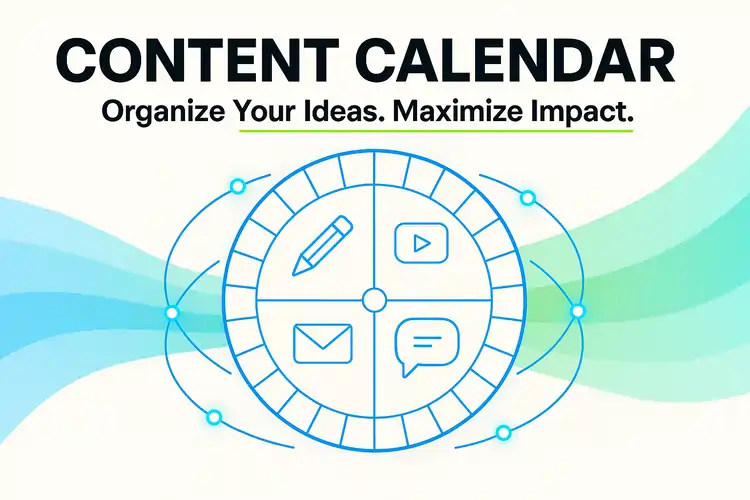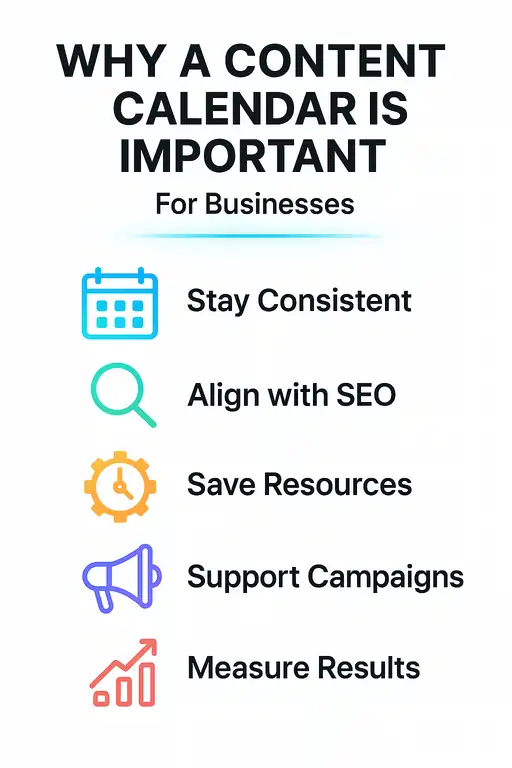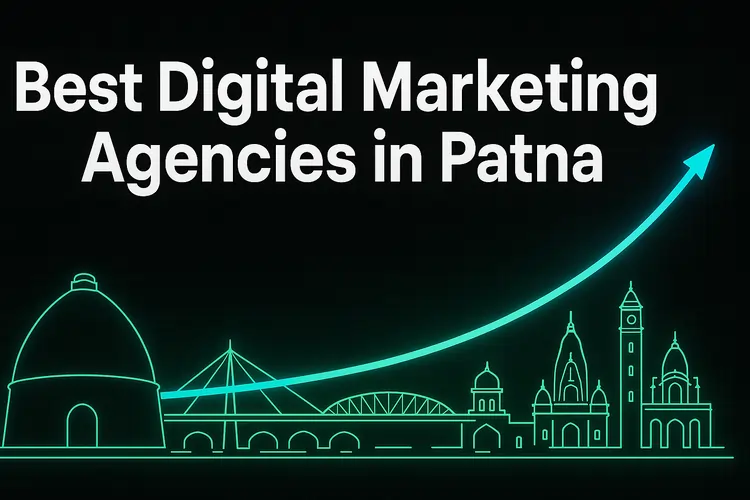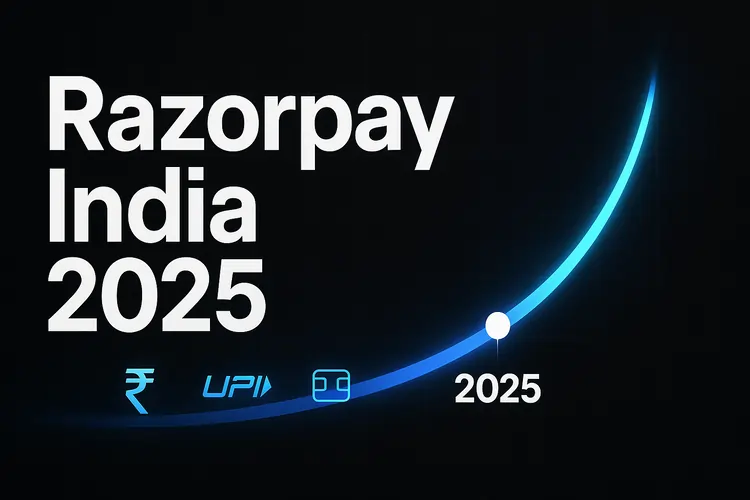Content calendar is the engine behind consistent digital growth. If you’ve ever missed a trend, skipped a post, or launched a campaign late, the problem isn’t creativity—it’s the lack of a structured content calendar.
I’m Deepak Singh, Founder of The DM School (Google Partner; 1 Lakh+ students trained). After building content calendars for startups and scaled brands across India, one truth is clear: businesses that plan ahead always outperform. A well-built content calendar aligns SEO topics, social media campaigns, product launches, and email flows—so every asset works toward one business goal.

In 2025, a content calendar in India is more than dates on a sheet. It’s intent mapping for SEO blogs, native formats for Instagram, LinkedIn, and YouTube, AI-assisted scheduling that saves hours, and E-E-A-T proof baked into every campaign. Done right, your content calendar becomes a flywheel: plan → publish → analyze → scale.
This guide is your India-first playbook—definition, benefits, types of content calendars, tools, templates, pricing, and real workflows we use at The DM School. Apply it to replace guesswork with a repeatable system that ranks, engages, and converts—month after month.
📑 Content Calendar Guide Outline
What is a Content Calendar? (Meaning + Examples)
A content calendar is more than a timetable — it’s a roadmap for your entire digital marketing strategy. It shows what content will be published, where it will go live, and when it will be distributed.
Think of it as a Google Calendar or Excel sheet, but dedicated to content planning. Every blog post, Instagram reel, YouTube video, or email campaign is mapped in advance to align with your marketing goals.
In India, brands that rely on ad-hoc posting often struggle with inconsistency. A content calendar solves this problem by making campaigns predictable, organized, and measurable.
Common formats of content calendars include:
- Excel or Google Sheets with columns for topic, platform, publish date, and status.
- Dedicated tools like Trello, Notion, or Asana for collaborative content planning.
- Social media scheduling apps like Buffer or Hootsuite that double as calendars.
Summary: A content calendar is a structured schedule that maps out all blogs, ads, videos, and emails in advance — ensuring consistency and alignment with digital marketing services and business goals.
Why a Content Calendar is Important for Businesses
A content calendar is more than a tool for organization — it’s the backbone of consistent digital marketing. Without one, most teams end up posting randomly, missing deadlines, and failing to align their efforts with business objectives.

With a well-planned content calendar, you can:
- Stay consistent: Publish regularly across blogs, YouTube, and social media instead of relying on ad-hoc posting.
- Align with SEO: Map content to keywords, search intent, and cluster pages — improving visibility with a trusted SEO company in India.
- Save resources: Prevent last-minute scrambles by having briefs, drafts, and designs ready in advance.
- Support campaigns: Sync product launches, seasonal sales, and festival promotions across all channels.
- Measure results: Track what’s working by comparing planned vs. published vs. performance metrics.
India Example: An eCommerce brand selling fashion apparel built a 3-month content calendar around Diwali and Big Billion Days. The calendar aligned blogs with festival SEO keywords, Instagram reels with influencer campaigns, and emails with discount drops — resulting in a 45% higher conversion rate compared to their previous unplanned efforts.
Summary: A content calendar ensures consistency, aligns with SEO strategies in India, supports campaigns, and improves ROI by turning content into a measurable system instead of random activity.
Types of Content Calendars (Social, Blog, Video, Email & More)
A content calendar comes in many forms depending on team size, goals, and platforms. Below are the most effective types businesses in India use in 2025 — with examples and tools for each.
1. Social Media Content Calendar
A social media content calendar helps you plan every post, caption, hashtag, creative, and publishing date across Instagram, LinkedIn, Facebook, and X. It prevents gaps in posting, ensures consistency, and makes it easy to align content with trending topics or campaigns.
India Example: A fintech startup in Bangalore used a 90-day Instagram content calendar during IPL, publishing reels tied to cricket trends. Engagement rose 300% because the calendar kept them consistent and timely.
Best Tools: Hootsuite, Buffer, Notion, Google Sheets.
2. Blog & SEO Content Calendar
A blog calendar maps out keyword clusters, publishing dates, target URLs, and internal links. It ensures that blog posts are not random but strategically tied to SEO goals. This type of content calendar is crucial for long-term organic traffic growth.
India Example: An edtech company created a blog content calendar targeting “digital marketing course in [city]” keywords for 12 metros. This systematic approach doubled organic traffic in 6 months.
Best Tools: Google Sheets, Trello, Asana, ClickUp.
3. Video Content Calendar
A video content calendar is designed for YouTube and Shorts. It tracks upload frequency, script outlines, thumbnails, SEO tags, and call-to-actions. A good video calendar ensures creators stay consistent and campaigns align with brand launches.
India Example: A D2C apparel brand planned a festival-driven campaign using a YouTube Ads in India case study framework. The calendar mapped Shorts, influencer collabs, and ads around Diwali, resulting in a 52% higher ROI.
Best Tools: Notion, Airtable, TubeBuddy, Google Sheets.
4. Email Marketing Content Calendar
An email content calendar covers newsletters, nurture sequences, promotional blasts, and product updates. It organizes subject lines, segments, CTAs, and scheduled send dates. It helps teams stay consistent and reduces the risk of overlapping or repetitive messages.
India Example: An eCommerce electronics brand built an email content calendar for Independence Day sales. The campaign synced with social ads, resulting in a 40% uplift in open rates and a 25% boost in conversions.
Best Tools: Mailchimp, Zoho Campaigns, HubSpot.
5. Paid Ads Content Calendar
A paid ads content calendar organizes campaigns across Google Ads, Meta Ads, and YouTube Ads. It covers ad copy variations, targeting sets, budgets, creatives, and testing cycles. This prevents overspending and ensures ads are optimized for performance.
India Example: A SaaS company created a paid ads calendar around quarterly product updates. It scheduled search ads, LinkedIn ads, and retargeting campaigns, improving ad CTR by 32%.
Best Tools: Google Ads Planner, Meta Business Suite, Excel.
6. Event & Seasonal Campaign Calendar
This type of content calendar focuses on festivals, national holidays, and shopping events like IPL, Diwali, or Flipkart’s Big Billion Days. It ensures every channel — blogs, ads, reels, and emails — syncs with the seasonal buzz.
India Example: A food delivery startup created a seasonal content calendar around Navratri, Diwali, and New Year. Each campaign included local offers, festival-themed posts, and push notifications, driving 60% higher order volume.
Best Tools: Google Calendar, Notion, Asana.
7. Influencer & Collaboration Calendar
An influencer content calendar manages partnerships, deliverables, and timelines. It tracks which influencer posts go live, where they are distributed, and what hashtags or CTAs they include. It helps brands avoid overlapping influencer campaigns.
India Example: A beauty brand in Mumbai tracked 15 influencers with an influencer calendar during its product launch. The structured rollout generated viral UGC, adding 25,000 new followers in 30 days.
Best Tools: Airtable, Notion, Asana.
8. PR & Outreach Content Calendar
A PR content calendar plans press releases, guest blogs, interviews, and media pitches. It ensures all outreach aligns with launches, funding announcements, or events. PR calendars reduce last-minute media rushes and maximize coverage.
India Example: A fintech company in Gurgaon launched a funding round and built a PR calendar mapping 10 press releases, 5 media interviews, and 20 LinkedIn thought-leadership posts. The campaign secured coverage in Economic Times and YourStory.
Best Tools: Google Sheets, Trello, Notion.
9. Integrated Multi-Channel Content Calendar
The most advanced type, this integrates blogs, social media, videos, emails, and ads into one master calendar. It is used by large teams to ensure every channel reinforces the same brand theme and campaign objectives.
India Example: A leading edtech brand created a 6-month integrated calendar linking SEO blogs, YouTube webinars, email funnels, and paid ads. This unified plan doubled lead volume and cut CPL by 40%.
Best Tools: Notion, CoSchedule, ClickUp, Airtable.
Comparison of Content Calendar Types
| Calendar Type | Best For | Popular Tools |
|---|---|---|
| Social Media | Engagement & branding | Notion, Hootsuite, Buffer |
| Blog & SEO | Rankings & traffic | Sheets, Trello, Asana |
| Video | YouTube & Shorts | Airtable, Notion, TubeBuddy |
| Retention & nurturing | Mailchimp, HubSpot | |
| Paid Ads | Campaign testing | Google Ads, Meta Suite |
| Event/Seasonal | Festivals & sales | Google Calendar, Notion |
| Influencer/PR | Partnerships & outreach | Airtable, Asana |
| Integrated | Full-funnel ROI | Notion, CoSchedule, ClickUp |
Summary: From social media posts and SEO blogs to paid ads, PR, and integrated campaigns — every business in India needs the right content calendar. Smart teams invest in integrated calendars to unify all channels into one growth engine.
How to Create a Content Calendar (Step-by-Step Template)
Creating a content calendar isn’t about filling a sheet with dates. It’s about building a workflow that keeps your content team consistent, accountable, and aligned with business goals. Follow this 7-step process to design a calendar that works.
Step 1: Define Your Goals
Decide whether your calendar should focus on traffic, leads, engagement, or conversions. A B2B SaaS might focus on lead gen blogs, while a D2C brand might prioritize Instagram reels.
Step 2: Research Topics & Keywords
Use tools like Google Keyword Planner, SEMrush, or Ahrefs to identify topics. Then, map them to funnel stages. For execution help, see our content writing page for strategies on keyword-rich blog posts and ad copy.
Step 3: Choose Content Formats
Blogs, videos, reels, emails, ads — list down which formats best suit your target audience. Multi-format calendars work best when each piece supports the same campaign.
Step 4: Assign Owners & Deadlines
Add columns for Responsible (writer), Accountable (editor), and Approver (manager). This prevents bottlenecks and ensures accountability across the team.
Step 5: Add SEO Fields
Include primary keyword, supporting keywords, internal links, and meta description. This makes the content calendar double as an SEO tracker.
Step 6: Plan Distribution Channels
List where each asset will be published — website, YouTube, LinkedIn, Instagram, email — and assign promotion tasks like boosting, repurposing, or influencer tie-ins.
Step 7: Track Performance & Refresh
Use a performance column to log CTR, impressions, leads, and conversions. Mark outdated pieces for refresh so your calendar never goes stale.
Summary: Define goals → research keywords → pick formats → assign owners → add SEO fields → plan distribution → measure performance. That’s how you build a content calendar that drives results.
Best Content Calendar Tools in 2025 for Businesses in India
A content calendar is only as good as the tool you use to manage it. From simple spreadsheets to advanced AI-driven platforms, the right choice depends on your team size, budget, and campaign goals. Here are the top tools businesses in India rely on in 2025.
1. Google Sheets & Excel
Perfect for startups and solo creators. Easy to customize with columns for topic, owner, status, keywords, and publish dates. Free and flexible — but requires discipline to keep updated.
2. Notion
A favorite for agencies and creators. Notion lets you combine calendar views, kanban boards, and content databases in one place. Great for collaborative planning with writers, designers, and editors.
3. Trello & Asana
Visual project management tools that double as content calendars. They offer drag-and-drop cards, due dates, checklists, and automation for smoother workflows.
4. Hootsuite & Buffer
Best for managing social media calendars. These platforms let you schedule, preview, and auto-publish posts across Instagram, LinkedIn, and X — while tracking analytics in one dashboard.
5. CoSchedule
A dedicated content marketing calendar tool. It centralizes blogs, emails, and social posts in one timeline, making it easy for large teams to sync campaigns.
6. AI-Powered Tools
AI tools help automate ideation, scheduling, and optimization. They can suggest the best posting times, generate draft outlines, and track performance patterns. Check our guide on best AI tools for business owners to see how Indian brands use them for smarter planning.
Summary: For small teams, Google Sheets or Notion is enough. For social-heavy campaigns, Hootsuite or Buffer works best. For scaling brands, CoSchedule or AI tools bring automation and intelligence to content calendar planning.
Free Content Calendar Templates (Download & Use)
One of the biggest challenges for businesses is not knowing how to start a content calendar. To make it simple, we’ve built free templates that you can customize in Excel, Google Sheets, or Notion. These templates help you avoid the blank-page problem and move straight into structured planning.
1. Monthly Blog Content Calendar Template
This template organizes blog titles, keywords, funnel stages, and publish dates. Great for SEO-focused teams who want steady growth through articles. Combine it with resources like our blog submission sites list to boost distribution and backlinks.
📥 Download the free template here:
Monthly Blog Content Calendar Template (Google Sheets)
2. Social Media Content Calendar Template
A plug-and-play sheet that helps you map out Instagram reels, LinkedIn posts, Facebook creatives, and YouTube Shorts. Includes columns for caption, hashtags, design file link, and scheduling date.
3. YouTube & Video Content Calendar Template
Ideal for creators and brands publishing video content. Tracks topics, scripts, upload dates, thumbnails, and performance metrics like CTR and watch time.
4. Integrated Campaign Calendar Template
A master calendar template that combines blogs, social posts, emails, and ads in one view. This is what large teams use to keep every channel aligned for product launches or seasonal promotions.
Summary: Use free templates in Sheets, Excel, or Notion to jumpstart your content calendar. Start with a simple blog or social template, then graduate to integrated campaign templates as you scale.
Content Calendar Examples from Indian Brands
Real calendars beat theory. Below are simplified, India-first examples showing how different teams plan (and actually ship) content week after week. Use these as blueprints and adapt to your goals, channels, and bandwidth.
A) D2C Skincare Brand — 30-Day Launch Sprint
- Objective: Launch a new Vitamin C serum and hit ₹15L in 30 days.
- Channels: Instagram Reels (3×/wk), YouTube Shorts (2×/wk), Blog (1×/wk), Email (1×/wk).
- Calendar Highlights:
- Week 1: Teaser reels + FAQ blog (“Vitamin C for Indian skin: myths vs facts”).
- Week 2: UGC reel prompts + comparison Short (“Vitamin C vs Niacinamide”).
- Week 3: Influencer collab Reels + email case snippet (before/after).
- Week 4: Offer countdown Reels + review round-up blog.
- Ops tip: Pre-book creators and design slots inside the calendar to avoid last-minute rush.
B) SaaS (Fintech) — SEO-Led Quarter Plan
- Objective: Rank for BOFU terms and reduce paid CAC by 20%.
- Channels: Blog (4×/mo), LinkedIn (3×/wk), Email (2×/mo), Webinar (1×/mo).
- Calendar Highlights:
- Month 1: BOFU blogs (“Best payment gateway for Indian SMBs”), comparison pages, LinkedIn carousels.
- Month 2: Product-led tutorials (UPI, GST), webinar with CA partner, email case-study drip.
- Month 3: Industry report blog + PR pitch, competitor comparison updates, retargeting content.
- Internal link: Pair BOFU blogs with service CTAs and a content brief built from our Content Writing Services approach.
C) EdTech — Exam Season Calendar
- Objective: Drive enrollments ahead of exam peaks.
- Channels: YouTube (2×/wk long-form), Shorts (3×/wk), Blog (2×/mo), Email (weekly).
- Calendar Highlights:
- Weekly: “Topic Sprint” video + Shorts cutdowns + summary email.
- Bi-weekly: “Doubt-clearing” live with timestamps → blog recap.
- Monthly: “Scholar success stories” video + BOFU email.
- Ops tip: Batch-record 4 long videos in a day, then schedule Shorts for the next two weeks.
D) Local Service Business (Legal) — Trust & Local SEO
- Objective: Increase qualified enquiries in Delhi NCR.
- Channels: Blog (2×/mo), Google Business Profile posts (2×/wk), LinkedIn (1×/wk), Email (1×/mo).
- Calendar Highlights:
- FAQ blogs targeting “near me” queries (plain-English summaries of procedures).
- GBP posts: micro-case updates, client testimonials, event notices.
- LinkedIn: “Explainer in 5 bullets” posts for founders/HRs.
- Internal link idea: Every FAQ blog links to your core service page and your content writing methodology page for authority and conversions.
E) National Campaign — Integrated 6-Week Plan
- Objective: Coordinate launch across blog, social, YouTube, and email to maximize reach.
- Calendar Highlights (by week):
- W1: Teaser assets + PR pitch; blog with “What’s coming & why it matters for India”.
- W2: Launch film + Shorts; email announce; landing page goes live.
- W3: Founder AMA live; product FAQs blog; testimonial collection begins.
- W4: “How we built it” behind-the-scenes video; use case blog series.
- W5: Offer push; retargeting creatives; partner collab posts.
- W6: Case results blog; thank-you film; nurture email into next product.
- Ops tip: Maintain a single master sheet with “Owner, Asset, Status, Link, Deadline” to keep all teams aligned.
Summary: Model your content calendar on proven Indian use cases—D2C sprints, SaaS SEO quarters, EdTech exam cycles, local SEO, and integrated national campaigns. Start focused, then layer channels as your ops mature.
Content Calendar Strategy for Marketing Success
A content calendar is not just about dates — it’s about building a long-term strategy that compounds results. Random posting brings random outcomes, but a strategic calendar ties every blog, video, or ad to a clear funnel stage and business goal.
1. Map Content to the Funnel
Start by identifying funnel stages: Awareness, Consideration, and Conversion. Your content calendar should plan content for each stage. Example: Awareness blogs → Consideration comparison videos → Conversion-focused case studies.
2. Build Around SEO & Demand
Use keyword research and trend analysis to decide what topics deserve a slot. This ensures your calendar isn’t based on guesswork but driven by data. Work with a trusted SEO company in India to align keywords, clusters, and publishing frequency with real search demand.
3. Sync Across Channels
A campaign should never live in isolation. Blogs should fuel LinkedIn posts, YouTube videos should be repurposed into Shorts, and emails should recap what’s trending. An integrated content calendar ensures all touchpoints reinforce each other.
4. Prioritize Evergreen + Seasonal Mix
Balance evergreen content (guides, how-tos, FAQs) with seasonal campaigns (Diwali, IPL, Independence Day). Evergreen content brings consistent traffic, while seasonal campaigns drive spikes and urgency.
5. Refresh, Don’t Just Create
Content calendars should include “refresh cycles” — revisiting old blogs, updating data, and republishing. This improves rankings faster than only creating new content.
Summary: A smart content calendar strategy maps content to the funnel, syncs across channels, balances evergreen with seasonal, and aligns with SEO demand. That’s how content transforms from noise into growth.
Common Content Calendar Mistakes to Avoid
Many businesses create a content calendar but still fail to see results. Why? Because they fall into common traps that make the calendar look good on paper but useless in execution. Here are the mistakes to watch out for:
1. Focusing Only on Posting, Not Strategy
A calendar filled with random posts won’t move the needle. Your calendar should map content to funnel stages and long-term SEO goals — not just “fill dates.”
2. Ignoring SEO Integration
Publishing without keywords, clusters, or internal links makes content invisible. Just like creating backlinks with a directory submission sites list boosts authority, aligning your content calendar with SEO principles ensures discoverability.
3. Overloading the Team
Ambitious calendars that demand 20 posts/week usually collapse after a month. Start with achievable frequency (e.g., 2 blogs + 3 reels/week) and scale gradually.
4. No Content Refresh Cycles
Old blogs lose ranking over time. If your calendar only adds new posts but ignores refresh slots, you’re leaving easy SEO wins on the table.
5. Missing Distribution Plan
Even the best content fails if no one sees it. A complete content calendar includes distribution via social media, email, PR, and partnerships — not just creation.
6. Treating It as Static
Markets and trends change fast. A content calendar must be flexible, with room for trending topics, industry updates, and newsjacking opportunities.
Summary: A content calendar fails when it’s random, SEO-blind, overloaded, static, or lacks distribution. Fix these mistakes early and your calendar becomes a growth engine, not just a scheduling tool.
How to Use AI in Content Calendar Planning
AI has become a game-changer for content calendar management in 2025. Instead of guessing what to post or manually filling dates, AI tools can analyze keywords, predict trends, and suggest optimal publishing times. But the key is to use AI smartly — as an assistant, not a replacement.
1. Idea Generation
AI tools like ChatGPT or Jasper can suggest blog titles, social captions, and video angles based on your niche. This helps eliminate blank-page syndrome while keeping your calendar full of fresh ideas.
2. Keyword & Topic Mapping
AI-driven SEO tools can analyze SERPs and map topic clusters directly into your content calendar. This ensures every slot supports organic growth instead of random posting.
3. Scheduling & Distribution
Platforms like Hootsuite and Buffer now include AI features that suggest the best posting times per channel. This makes your calendar more effective by aligning with audience activity.
4. Performance Analysis
AI doesn’t just help in planning — it also learns from past performance. Tools track which posts drove engagement or leads and recommend adjustments for future calendar cycles.
5. Human + AI Collaboration
The best results come when AI and humans work together. AI handles speed and pattern recognition, while humans bring creativity, cultural context, and strategy. That’s why many businesses partner with digital marketing services that integrate AI into execution.
Summary: AI makes content calendars smarter by generating ideas, mapping SEO topics, optimizing schedules, and learning from performance. But the winning formula is AI speed + human strategy.
Content Calendar Pricing & Services in India
How much does it cost to build and manage a content calendar in India? The answer depends on whether you DIY, hire freelancers, or work with a professional agency. Let’s break it down with realistic 2025 figures.
1. DIY / In-House Teams
If you or your in-house marketer manage the calendar, the cost is mainly time. Tools like Google Sheets or Notion are free, while paid upgrades (Asana, Hootsuite) cost ₹1,000–₹6,000/month. The challenge is consistency and bandwidth.
2. Freelancers
Freelancers charge between ₹10,000–₹40,000/month to create and maintain calendars. This usually covers planning blogs, reels, and emails, but may lack strategy depth or distribution expertise.
3. Agencies
Hiring a professional agency costs anywhere between ₹25,000–₹1,00,000/month depending on scope. Agencies not only create the calendar but also align it with SEO, social campaigns, and content execution. Many also offer content writing services bundled in.
4. Enterprise / Advanced Packages
Large brands that need multi-channel calendars (blogs, YouTube, paid ads, PR) often pay ₹1,50,000–₹5,00,000/month. These packages include strategic planning, content refresh, analytics, and dedicated account managers.
Summary: Content calendar costs in India range from free DIY tools to ₹5L/month enterprise packages. Agencies often deliver the best value by combining content writing, SEO, and campaign planning under one roof.
Content Calendar FAQs (Quick Answers)
1. What is a content calendar?
A content calendar is a structured schedule that organizes blogs, videos, social posts, and emails. It maps dates, owners, and goals to ensure consistent publishing and measurable results.
2. Why is a content calendar important for SEO?
It ensures content is planned around keywords, clusters, and backlinks. By aligning publishing with SEO goals, a content calendar improves rankings and organic traffic.
3. How far ahead should I plan a content calendar?
Most businesses plan 1–3 months ahead. For seasonal campaigns like Diwali or IPL, plan at least 2 months in advance to secure design, production, and distribution slots.
4. Can AI create a content calendar?
Yes, AI can generate ideas, suggest posting times, and analyze performance. But human input is essential for strategy, storytelling, and cultural relevance in India.
5. How do I make a YouTube content calendar?
Plan scripts, upload dates, thumbnails, and Shorts alongside long videos. Use tools like Notion or Airtable, and follow our guide on YouTube SEO in India for better reach.
6. How much does a content calendar cost in India?
DIY calendars are free. Freelancers charge ₹10k–₹40k/month. Agencies cost ₹25k–₹1L+, with enterprise plans going up to ₹5L/month depending on scope and services included.
Summary: A content calendar keeps campaigns consistent, SEO-aligned, and easier to manage. Plan 1–3 months ahead, mix AI with human inputs, and use tools that fit your team size.
Conclusion: Content Calendars as Your 24×7 Growth Engine
A content calendar is more than a scheduling tool — it’s a growth engine. It brings consistency, aligns campaigns with SEO, and ensures your team never misses opportunities around festivals, product launches, or industry trends.
Whether you’re a startup founder, a marketing lead, or a creator, a content calendar keeps every blog, reel, email, and ad working together. The result? Higher visibility, stronger brand authority, and measurable ROI.
If you’d rather skip the trial-and-error and work with experts, explore our Digital Marketing Services. At The DM School, we help Indian businesses design and execute content calendars that don’t just look good on paper — they deliver real traffic, leads, and sales.
🚀 Ready to Scale With a Content Calendar?
Book a free strategy call with The DM School and let us build your calendar-driven growth system.
Summary: Done right, a content calendar becomes a 24×7 growth engine for your business. Pair it with the right strategy and expert support to dominate your niche.


